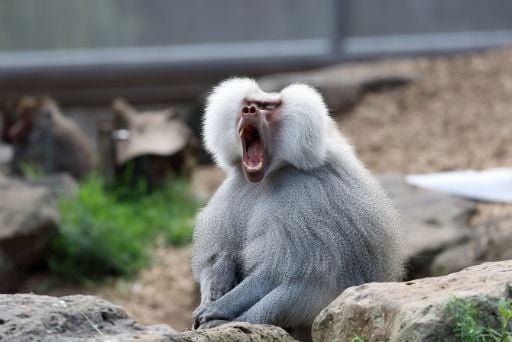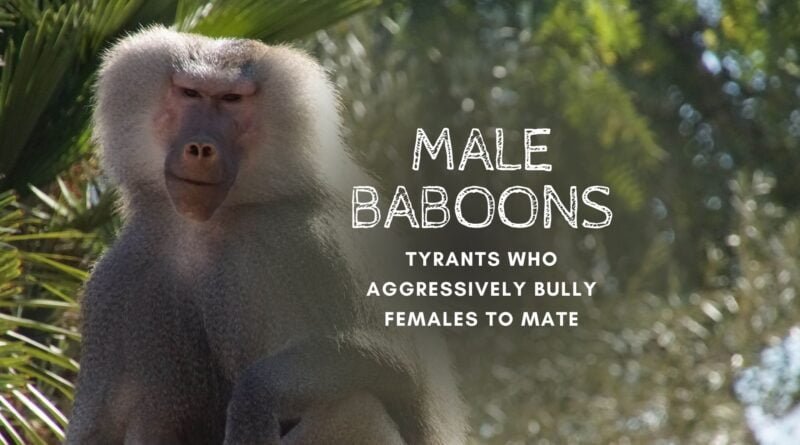Male baboons are tyrants who aggressively bully females to mate
A team of three French and British researchers discovered that male Baboons use aggressive, violent tactics to tame females and maximize their mating success rates — a rare display of sexual intimidation previously observed only in humans and chimpanzees.
Throughout diverse animal taxa, courting female animals demand a laborious effort from the male animals. For a single mating event, the males first have to seduce the potential mating partners.
It’s not easy for male animals to court and impress their female mating partners for a successful copulation. They have to run their mind to come up with winning tactics to get a green single from a female.
To dazzle and captivate the mating partners, males across various animal taxa have been documented to manifest extensive courtship strategies. Males produce court songs, show off their physical fitness & enchanting dance moves, and give nuptial gifts (prey, nutritious liquids, or self-sacrificing), etc to attract females for copulation.

However, not all males care to win over the females, some simply use forceful and aggressive tactics to tame their female mating partners. A 2017 study found that male baboons are tyrants who aggressively abuse their potential mating partners to mate – a rare demonstration of sexual intimidation by baboons.
The research article was published online in an open-access journal from Cell Press called Current Biology on July 06, 2017.
Current Biology is a well-known journal that regularly publishes original research articles and reviews. The journal mainly publishes research papers related to diverse fields of biology. One of the many objectives of “Current Biology” is to encourage communication between the various fields of biology. The journal publishes key findings of general interest from different fields of biology. The journal aims to share the latest knowledge with experts and common people.
The team of researchers stated that aggressive mating practices, previously only observed and documented in human beings and chimpanzees, may be more common and widespread around the diverse animal taxa as well.
The research team included postdoctoral researcher, Alice Baniel, from the Institute for Advanced Study in Toulouse, France — Guy Cowlishaw, a research fellow, from the Institute of Zoology, Zoological Society of London — and a behavioral ecologist, Elise Huchard, from the Montpellier Institute of Evolutionary Sciences, University of Montpellier, France.

Before the 2017 research, scientists had only observed sexual intimidation in humans and chimpanzees.
A handful of behavioral biologists have studied sexual violence in chimpanzees but hardly anyone notices this particular behavior in baboons.
“Sexual intimidation was believed to be a frequent case only in humans and chimpanzees”, stated the research team.
The research team studied chacma baboons behavior and demonstrated how male baboons intimidate and beat up females to mate with them. The research team also stated that 70% of injuries on the female bodies were resulted due to male intimidation and bullying.
Alice Banie and her research team believe that sexual intimidation and violence may be more widespread in animals than scientists presume. Male baboon’s aggression toward his potential mating partner provides him with delayed but guaranteed mating success rates.
To study this sexual intimidation more extensively, Alice Banie and her colleagues studied wild chacma baboons at Tsaobis Nature Park for almost four years. The park is located in a semi-arid environment in Namibia. The team monitored the behavior and collected data from dawn to dusk. The team divided the baboon into habituated groups, called “J” and “L”.
After four years of extensive observation and data collection, the research found substantial data that male baboons’ aggressively bullied cycling females compared to mated and pregnant female baboons. The research team also found that male baboons’ aggression increased their mating success in the near future with the females who were abused by them.
“We found that a female chacma baboon who received more aggressive bullying from the aggressor was more likely to be mate-guarded by him during her heat cycle”, stated the research team.

This might sound abhorrent but where other male animals (mammalian and non-mammalian) put great efforts and sweetly court their females, male baboons use aggression and violence toward female mating partners as courting or sexual coercion.
The research team also elucidated the chronological sequence between male baboons’ aggression and mating. Male baboons frequently threatened (including head bobbing, ground sweeping while oriented toward the targeted individual, and intense staring), harassed, and punished (including punches, bites, or grabbing movements) their females.
The research team also tested the alternative hypotheses such as females’ preference for abusive males – but they didn’t find any proof supporting such hypotheses.
According to the researchers, this is the first-ever, detailed study to suggest that sexual intimidation or sexual violence may be widespread across diverse mammalian taxa than previously assumed. Future studies need to focus more on the evolution of sexual conflict and mate preference in mammalian societies. The research team also encouraged researchers to extensively study the origins of human sexual violence.




